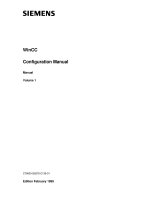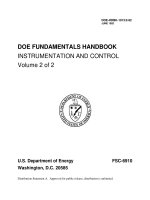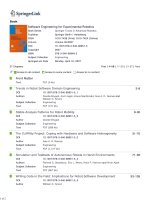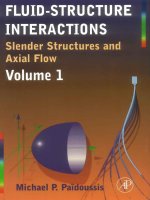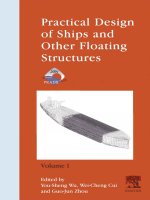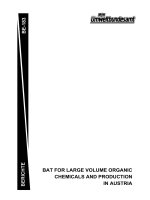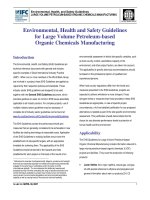Bioanalytical separations volume 4
Bạn đang xem bản rút gọn của tài liệu. Xem và tải ngay bản đầy đủ của tài liệu tại đây (31.43 MB, 433 trang )
www.pdfgrip.com
www.pdfgrip.com
www.pdfgrip.com
www.pdfgrip.com
www.pdfgrip.com
www.pdfgrip.com
www.pdfgrip.com
www.pdfgrip.com
www.pdfgrip.com
www.pdfgrip.com
www.pdfgrip.com
Preface
"Nothing tends so much as to the advancement of knowledge, as the
application of a new instrument. The native intellectual powers of men in
different times are not so much the causes of the different success of their
labour, as the peculiar nature of the means and artificial resources in
their possession"
Sir Humphrey Davy, 1840
In the context of this volume "bioanalysis" has a very specific meaning. It is the analysis
of drugs and their metabolites in biological fluids. There is probably no field which has
benefited from the introduction of new instrumentation and ways of analysing samples
as much as this type of analysis. Today the laboratories of pharmaceutical companies,
and the contract houses that serve them, are filled with sophisticated HPLC-MSMS
systems devoted to the analysis of compounds at concentrations unachievable by
previous generations of analysts. Thus, detection and quantification at concentrations
below 1 nanogram per millilitre are now commonplace, and the pace of innovation
seems still to be increasing. The bulk of these advances in bioanalysis have resulted
from the development and implementation of robust and sensitive HPLC-MS interfaces.
The high capital cost of much of this instrumentation has also led to increasing pressures
on improving the efficiency of method development and instrument usage.
The application of these new HPLC-MS-based methods is covered in this volume in
chapters on forensic bioanalysis and the role of this way of analysis in drug discovery.
However, despite the success of such devices, all of the problems of bioanalysis have not
been solved by their introduction, and there is a continuing need for sustained
innovation. In particular the low concentrations, and the presence of large amounts of
endogenous interferences in biological fluids and tissues, has meant that sample
preparation techniques remain of prime importance to the bioanalyst seeking the highest
sensitivities and specificity. This activity is reflected in several contributions on the
theme of sample preparation. Chromatography is still important, even when the detector
is as sensitive and specific as the mass spectrometer is claimed to be, and new phases
of the types described in this volume, providing chiral separations or improvements in
conventional chromatography, are always needed. In addition the linking of spectrometers other than mass spectrometers has been an important area of innovation, and this is
reflected in contributions on HPLC-NMR and HPLC-ICPMS.
Finally, it has always to be remembered that, because of the importance of
bioanalytical data in the generation of regulatory submissions, such work is subject to
www.pdfgrip.com
vi
Preface
very precise and challenging regulatory control. The needs of the regulators for
bioanalytical separations are therefore also covered in the final contribution to the
volume.
I would like to thank all of the authors who have contributed to this work for their
time, patience and expertise. The collected wisdom and scholarship that these chapters
reflect have been a source of considerable pleasure and education to me as I have put
the volume together.
Ian D. Wilson
AstraZeneca
Macclesfield, U.K.
www.pdfgrip.com
I.D. Wilson (Ed.), Bioanalytical Separations
Handbook of Analytical Separations,Vol. 4
9 2003 Elsevier Science B.V.All rights reserved
CHAPTER 1
New developments in integrated sample
preparation for bioanalysis
M.W.J. van Hout l'*, H.A.G. NiederRinder ~, R.A. de Zeeuw 1 and G.J. de Jong 2
Department of Analytical Chemistry and Toxicology, University Centrefor Pharmacy, University of
Groningen, A. Deusinglaan 1, 9713 AV Groningen, The Netherlands
2 Department of Biomedical Analysis, Faculty of Pharmacy, University of Utrecht, P.O. Box 80082, 3508 TB
Utrecht, The Netherlands
* Current address: Pharma Bio-Research Group B.V., Laboratories Assen, Westerbrink 3, 9405 BJ Assen,
The Netherlands
1.1 INTRODUCTION
Increasing knowledge of the working mechanisms of drugs has led to the development
of very potent drugs. Hence, the administered dosages are small, and consequently, the
concentration levels in biological fluids are decreasing. Furthermore, biological samples
are very complex, because they contain many endogenous substances. Blood fluids,
such as serum and plasma, represent an extra problem due to the presence of proteins.
Protein binding may affect the extractability of the analytes. Deproteinisation
techniques can help to overcome this problem. It may, however, also give rise to even
more difficulties, since analytes can be co-precipitated with the proteins. Thus, sample
pretreatment techniques are required that retain the analyte(s) of interest, at the same
time efficiently removing the endogenous interferences. The most common systems
exist of an extraction step prior to separation and detection. A considerable gain in
sensitivity and selectivity can be obtained during the extraction, as the analytes of
interest are usually concentrated and separated from the matrix. An ideal extraction
method should be rapid, simple, inexpensive, and give reproducible and high recoveries
without the possibility of degradation of the analytes. Furthermore, the extraction
method should not generate large amounts of chemical waste [ 1].
Sample pretreatment used to be a long step in the analysis of biological samples.
Since the numbers of samples to be analysed is increasing, very rapid, but still selective
and sensitive systems are required. In modern systems using advanced sample handling,
the separation step may be more time-consuming. However, with the introduction of
short columns in liquid chromatography (LC) and the selectivity of the mass
spectrometer (MS), throughput of samples is again more and more limited by the time
References pp. 39-44
www.pdfgrip.com
2
Chapter 1
required for sample pretreatment. This is especially the case in off-line systems, which
may also require extensive manual work. Therefore, various systems have been
developed in order to integrate sample pretreatment with the separation and detection
technique (Fig. 1.1) [2].
Sample
pretreatment
!i~,,~iiii!ii~ ~,~ ~i!~ii!ii~i
Separation/Detection
Off-line
At-line
On-line
In-line
Fig. 1.1. Schematic presentation of various integration methods of the sample pretreatment step with the
separation and detection technique. (Reprinted from [2, modified], with permission from Elsevier Science).
www.pdfgrip.com
New developments in integrated sample preparation for bioanalysis
Basically, three possibilities have been proposed for integrated sample pretreatment
in the analytical procedures, i.e. (1) at-line; (2) on-line; and (3) in-line. The at-line
coupling involves sample preparation by a robotic device and an autoinjector to inject
the extracts into the analytical instrument. No direct stream of liquid between extraction
unit and analysing unit is present. Moreover, not the entire extract is transferred to the
analysing instrument. Disadvantages as observed with off-line extractions, i.e.
collection of the extract, evaporation and reconstitution, are not eliminated. An example
of an at-line system is the 96-well plate design for solid-phase extraction (SPE).
Samples can be extracted simultaneously, thus increasing the sample throughput,
provided that the separation and detection can be performed very rapidly or by using
simultaneous analytical instruments. With on-line systems, there is a direct transport of
the entire extract to the analysing technique, and the latter is receiving the entire extract.
Samples can be processed in series, i.e. samples are pretreated and analysed one after
the other, or in parallel, in which one sample is being analysed while another is being
extracted. The latter system offers a high sample throughput. A very prominent
advantage of on-line systems is that some error-prone steps of the extraction procedure,
such as evaporation and reconstitution are eliminated, hereby increasing precision and
accuracy. In-line systems exist of sample pretreatment fully incorporated into the
separation system, hereby creating a new device. In contrast to on-line procedures,
application of in-line systems imply the direct injection of the sample into the analytical
instruments. Various approaches for in-line SPE-capillary electrophoresis have been
reported [2]. It should be noted that the differences in interfacing are often not as clear
as mentioned above. For example, the extraction can be performed manually (off-line)
or by robot (at-line), but the final step of the extraction, i.e. the desorption of the
analytes may be performed on-line with the analytical step. Furthermore, dividing
systems into on-line and in-line techniques is very disputable. These systems are usually
closely related to each other and a distinct difference can often not be made. Therefore,
in this chapter on-line and in-line systems will be considered as similar.
The goal of this chapter is to show the current status of modem sample pretreatment
techniques such as SPE, solid-phase microextraction (SPME) and membrane-based
extraction systems, and to outline novel trends in the bioanalytical area with regard to
integrated sample preparation. It will focus not only on pretreatment techniques
integrated with chromatographic separation systems, but also on their direct coupling to
MS. SPE was originally designed for off-line purposes [3-5], but is now routinely used
in on-line systems with LC [6-9]. The combination of SPE on-line with gas
chromatography (GC) is less common, especially in the bioanalytical field. The current
state of SPE-GC will be discussed here. Since an LC column can also be used as cleanup prior to GC analysis [10-13], on-line LC-GC applications without any further
sample pretreatment will also be presented. Turbulent-flow chromatography (TFC) is to
a certain extent similar to SPE. The use of high flow-rates offers new possibilities for
sample pretreatment [14-17]. Therefore, the current state in TFC will be presented.
SPME was originally designed for the analysis of volatile compounds with GC [18-22].
However, nowadays SPME is also coupled with LC for analysis of less-volatile
compounds. The applicability of these SPME-LC systems in bioanalysis will be shown.
Membrane-based techniques are, like SPME, diffusion-based sample pretreatment
References pp. 39-44
www.pdfgrip.com
4
Chapter 1
techniques. Dialysis is a more mature membrane method for sample pretreatment
[23-25]. However, non-porous membranes provide new challenges for clean-up of
biological samples. Therefore, the focus of membrane-based techniques for sample
clean-up will be on the latter type.
1.2 CHROMATOGRAPHY-BASED EXTRACTION TECHNIQUES
1.2.1 Solid-phase extraction - gas chromatography
1.2.1.1 General aspects of SPE
A very common and powerful sample clean-up and concentration technique is SPE. It
was originally developed for off-line purposes, but due to the demand for speed and the
growing numbers of samples, at-line (including 96-well designs [9,26,27]) and on-line
systems, such as the Prospekt, have been developed for coupling with LC [6,7,28,29].
On-line SPE is a very attractive sample pretreatment technique since the entire process
of activation, conditioning, extraction, washing, and elution takes place in an enclosed
circuit, which eliminates error-prone steps like evaporation and reconstitution. Also, the
entire eluate is usually injected into the analytical instrument. Therefore, better
precision and sensitivity may be observed when compared to off-line SPE.
The most common on-line coupling of SPE is with LC, since similar solvents are used
and virtually no modifications have to be made to the instruments. As this technique has
already evolved and matured, the on-line coupling of SPE-LC will not be discussed
here in detail. Worth mentioning, however, is the growing interest for high-throughput
systems based on short-column LC coupled with MS, or even direct coupling of SPE
and MS [30-39]. In such systems the extraction and detection should offer both
sensitivity and selectivity in order to be able to detect low quantities of analytes in
biological fluids. It should be noted that many applications applying little or no
separation prior to MS may have to deal with ion suppression effects [31,40-43], clearly
showing that the SPE eluates are not always free of matrix compounds.
Numerous applications on off-line SPE-GC have been reported for the analysis of
biological samples, and various reviews have appeared to which the reader can be
referred [3-5]. Also, at-line systems, e.g. PrepStation [44,45] and ASPEC [46,47], will
not be considered here. With the latter systems the extraction is performed
automatically, but the eluate is collected in vials and subsequently the eluate is, usually
only partially, injected into the GC. Numerous applications have been reported about the
usefulness of off-line SPE combined with gas chromatography for analysis of biological
samples. However, on-line SPE-GC appears to be emanating as a rather unexplored, yet
promising technique.
The on-line coupling of SPE with GC implies injection of large volumes of solvent
into the GC, thus requiring modification of the injection system. A number of interfaces
have been proposed for this purpose [48], i.e.: (1) on-column injection; (2) loop-type
injection; and (3) programmed temperature vaporiser (PTV). With on-column injection,
solvent is introduced at a speed above the evaporation rate and at temperatures below the
boiling point of the solvent, ensuring wetting of the retention gap [49]. Solvent is
www.pdfgrip.com
New developments in integrated sample preparation for bioanalysis
evaporated in the retention gap and eliminated via the solvent vapour exit (SVE). An
extra retaining pre-column enables refocusing of the analyte prior to transfer to the
actual analytical column. A second way to allow large-volume injection (LVI) is the
loop-type interface, originally designed for on-line LC-GC [50]. Injection is performed
by filling a loop and flushing the contents to the retention gap inside the GC, which is
slightly above the boiling point of the solvent. Formation of vapour results in pressure
build-up and prevents further penetration of the solvent into the retention gap. Finally,
a PTV injector was designed by Vogt et al. [51,52]. The injector strongly resembles a
conventional split/splitless injector. The main difference is injection of solvent at
temperatures 30-40~ below its boiling point on a packed liner. The liner packing acts
as a liquid reservoir. A high purge flow ensures evaporation of the solvent, while
analytes are retained on the liner packing. After almost complete evaporation of the
solvent, the analytes are thermally released from the packing and transferred to the GC
column. The latter is still at low temperatures, allowing refocusing of the analytes.
1.2.1.2 Applications of SPE-GC
A selective SPE-GC method was described by Farjam et al. [53], who coupled
immunoaffinity sample pretreatment with GC. A column with immobilised antibodies
was used for the extraction of [3-19-nortestosterone from urine. A reversed phase
reconcentration column and a retention gap were used for interfacing the extraction and
the GC. Desorption from the antibody-column was performed with methanol-water
(95:5, v/v), and after subsequent dilution with water, the analytes were trapped on the
reconcentration column. Elution from this column was performed with 75 p~l ethyl
acetate. The high selectivity during trapping made it possible to analyse large urine
samples (5-25 ml), with good sensitivity for all investigated steroid hormones (LOD
about 0.1 ng/ml). The total analysis time was still 40 min, mainly due to the long GC
analysis.
Benzodiazepines were determined in plasma by on-line dialysis-SPE-GC [54].
Clean-up was based on performing dialysis for 7 min, and subsequently, the diffused
analytes were trapped on a PLRP-S pre-column. After drying elution was performed
with 275 p~l ethyl acetate, which was injected into the GC via a loop-type interface. The
SPE step in this procedure was more a reconcentration step than an actual extraction
process. Nonetheless, this on-line dialysis-SPE-GC system showed sufficient selectivity
(Fig. 1.2). The authors claim that the benzodiazepines could be detected at therapeutic
levels (5-25 ng/ml) and that extra selectivitity could be obtained by acidification of
plasma prior to extraction (Fig. 1.2C and D), but these claims are not substantiated by
their figures.
The PTV injector is an interesting injection system, as it allows LVI and thus on-line
LC-GC and SPE-GC. The possibilities of PTV-GC in combination with SPE for
plasma samples have already been demonstrated [55]. Now that integrated, automatic
instruments have become commercially available, on-line SPE-PTV/GC will be
facilitated. Moreover, the PTV injector also offers possibilities for thermal desorption
[10,56-60]. Thus, no solvent is introduced into the GC, hereby eliminating some
difficulties observed with LVI-GC, such as introduction of large volumes of solvent and
its evaporation within the GC system. However, the reports available so far all deal with
References pp. 39-44
Z
Time (min)
15
20
QJ
E
Time (rain)
25
Fig. 1.2. On-line dialysis-SPE-GC-NPD of (A) untreated blank plasma, (B) untreated plasma spiked with 1 la,g ml -J of nitrazepam, (C) acidified blank plasma and
(D) acidified plasma with 1 lu,g ml -~ of medazepam. (Reprinted from [54], with permission from Elsevier Science).
50 mVI
E
O",
www.pdfgrip.com
www.pdfgrip.com
New developments in integrated sample preparation for bioanalysis
environmental samples. Finally, the PTV injector has also been used for direct injection
of plasma samples [61 ]. In this set-up, acidification and subsequent ultrafiltration were
the only sample pretreatment steps. About 50 ~1 of the ultrafiltrate were injected onto
a packed liner. No interference of the matrix was observed (see Fig. 1.3) and the
chromatographic system was not damaged. The only drawbacks were occasional
memory effects and the necessity to change the liner after 20 injections. The latter is
probably due to the injection of ultrafiltrates which still contain some proteins, causing
adsorption to the liner packing and GC column. The quantitation limit for ropivacaine
was down to 300 pg/ml.
1.2.1.3 Remarks regarding the applicability of SPE-GC
New devices have been developed for the coupling of miniaturised SPE with GC
[62,63], enlarging the possibilities for incorporation of on-line SPE-GC into routine
analysis. Until now, the number of applications of on-line SPE-GC in bioanalysis is
very limited, in contrast to the numerous reports of this technique in the analysis of
surface and drinking water [10-12,64,65]. This is probably due to the complexicity of
biological matrices in comparison with water samples. Furthermore, various compounds
in biomedical and pharmaceutical studies cannot be analysed with GC due to
thermolability of the compounds. Nevertheless, the applicability of SPE-GC with LVI,
and in particular the PTV injector, for biological samples seems worth further
exploring.
1.2.2 Liquid chromatography - gas chromatography
1.2.2.1 General aspects of LC-GC
A similar approach to SPE-GC is the coupling of LC on-line with GC in which the LC
column functions as a sample pretreatment technique. Only the fractions of interest will
be transferred to the GC (heart-cutting). The LC column is merely used for clean-up
purposes and the GC column is used for the actual separation. As with on-line SPE-GC,
on-line LC-GC also implies the introduction of relatively large liquid volumes into the
GC, so that LVI must be used. As discussed with on-line SPE-GC, several approaches
have been proposed in order to allow injections up to 1 ml into the GC. Nearly all online LC-GC applications involve normal phase (NP) LC, since the introduction of
volatile elution solvents into the GC is more easily achieved than that of aqueous
solvents [10]. However, direct analysis of biological, i.e. aqueous, samples in NPLC is
not possible. Therefore, a separate sample pretreatment step, e.g. LLE or SPE, is always
required. Consequently, no applications in the bioanalytical field have been reported for
on-line NPLC-GC with direct injection of the sample.
It is more common to use reversed phase (RP) LC in biomedical and pharmaceutical
analysis. Coupling RPLC with GC implies introduction of large volumes of aqueous and
ionogenic solutions into the GC. Water is very disadvantegous for GC analysis due to
its high boiling point, high surface tension, poor wetting characteristics and aggressive
hydrolytic reactivity, whereas non-volatile buffers (i.e. its ions) are also non-compatible
References pp. 39-44
0
0
1oo
0
100
. . . .
I
. . . .
0:40
m/l:131
ml z : 126
"
. . . .
. . . .
Time
9:00
I
. . . .
(min)
'
I ....
9:20
9653 i,I
n94,~.
""~'''1
Blank plasma
9:40
r
....
. ~04
S.4ab
g*04
2.67S
Z+04
1.222
lO:OO
-
-
o
10
40
60
80
ZOO
o
20
40
60
80
100
0
2O
4O
100
....
,~
)37
11:47
.14944
/i
47780
8 : 4, 0. . . . . . . .
m/-"-o.13.1
n / 9 9 12S
n/z:lli
351
....
..
,oo':'- . . . . . . .
" ' '
8:$4
254)6
40097
Time
(min)
,2-:'o
2t$1S!
4S4~37
I:|4
)TI
~I$14$
z2~2o
)|1
9:15
'
Plasma sample
,r .
.
J : 4' 0
.
.
.
.
......
.
|
lO:O0
1.119
9 g-iS
t.4t0
Fig. 1.3. Chromatograms obtained from extracted blank plasma and from plasma spiked with analytes (400 nM each) and I.S.: (A) PPX (m/z: 84), (B) ropivacaine
(m/z: 126) and (C) internal standard ropivacaine-D7 (m/z: 133). (Reprinted from [61], with permission from Elsevier Science).
(c)
(B)
(A)
:r
www.pdfgrip.com
www.pdfgrip.com
New developments in integrated sample preparation for bioanalysis
with GC. Nonetheless, several techniques have been proposed for the analysis with online RPLC-GC [10-13,66-69]. Basically, they can be divided in two groups: (1) direct
introduction of aqueous RPLC fractions using special GC-injection systems; and (2)
phase-switching techniques, by which the analyte is transferred to an organic solvent
prior to introduction into the GC. In the latter situation RPLC is coupled to GC via online LLE. Both approaches have found their way in environmental analyis [11-13], but
the number of applications in bioanalysis is very limited. In a few cases RPLC has been
coupled on-line with GC for the analysis of biological samples using an off-line sample
preparation, i.e. LLE [70] or SPE [71] was applied prior to injection into the LC
system.
1.2.2.2 Applications of RPLC-GC
An example of the first approach, i.e. direct introduction, was described by Duquet and
co-authors [72], who coupled ~RPLC on-line with GC using a aminopropyltriethoxysilane-deactivated retention gap. Diazepam was determined in urine by transferring only
2-~1 methanol-water (80:20 v/v) fractions from the LC into the GC. Goosens et al.
[73-75] also applied a retention gap to transfer eluents from the RPLC to the GC for
drug analysis. Up to 200 ~1 of eluent (acetonitrile-water) could be introduced into a
Carbowax-deactivated retention gap by using an on-column interface and SVE [76]. The
presence of remaining water after azeotropic evaporation was found to deteriorate the
analysis. Thereofore, prior to introduction into the GC, addition of 10% acetonitrile to
the LC eluent was performed resulting in an azeotropic acetonitrile-water mixture
(84:16 v/v). By these means, the maximum amount of water remaining after
evaporation was never exceeded. In order to inject ion-free fractions into the GC an
anion-exchange micromembrane was inserted between the LC and GC parts [74].
Methanesulphonic acid was efficiently removed (99.9%) from the eluent acetonitrilewater, allowing the reproducible analysis of the potential drug eltoprazine, i.e. the
coefficient of variation was found to be 3% (n = 5, 150 ~g/ml).
A different approach, i.e. phase switching, was applied by Wessels et al. [77] and
Ogorka et al. [78]. A phase switch was performed by using an LLE interface between
the LC and GC part (loop-type interface). The set-up of this system is depicted in
Fig. 1.4. Use of a GC-MS system allowed the identification of various unknown
impurities in pharmaceutical products. Even though the instrumental set-up is rather
complicated, reliable results were obtained for the quantitative determination of [3blockers in human serum and urine [79,80]. A total analysis time of 45 min. was
required for the selective removal of the matrix compounds and efficient and repeatable
LLE-GC analysis. Hy6tyl~inen et al. [81] applied a similar system to determine
morphine and its analogues in urine. After LC separation, a phase switch was applied
using an elevated temperature for the eluent and the extraction coil, which resulted in
increased recoveries. After phase-switching, the analytes were derivatised on-line with
N,O-bis(trimethylsilyl)trifluoroacetamide prior to GC-FID analysis. The total analysis
time was less than 60 rain. As can be seen in Fig. 1.5, the LC clean-up procedure was
effective as no matrix compounds were observed. Extra peaks in the chromatogram are
due to the excess of derivatisation reagent. In principle this is a very powerful system.
However, although the above studies show interesting approaches, the utility of the
References pp. 39-44
Separat ion
Column
--
EarLy Vapor EJ~iL
I~etaintng Retention
Precolu~n Gao
GC
kC Colux.n
{llest r ict ion)
:.
,~l~]
1]]]]s
2
|O-Portvalye
~ . / V V V V " 5 o o I J | sample L~176
--
Flow
Pressure
Regulator Regulator
waste
Resl~rictor
L ~
_ _
~ ~l Lo~_W~_
e
Va!ve
Restrtctor
NeeOle
T
Cooljng Bath w| th
j Extract ion Coil Sandwich TyDe
i
Phase Separat~ I Detect~ i
Restrictor ]
---
-~Waste
Fig. 1.4. Instrumentation for on-line coupled reversed phase LC-GC-MS. (9 John Wiley & Sons Inc. Reproduced from [77] with permission).
MS
i ,
-
1
Extraction
i i li$ olvent
I HPLC-Pu~ 1-~)~.=~(- - -u
~
Ll)w Pressure valVeFlP.Column
il,,l
www.pdfgrip.com
www.pdfgrip.com
New developments in integrated sample preparation for bioanalysis
11
135
2
80
3
mV
1
5
26
L
135
80
mV
26
o
. . . . . ~o
20
Time (rain)
30
40
Fig. 1.5. GC chromatograms of (top) urine spiked with the opiates and (bottom) blank urine. Peaks: (1)
dihydrocodeine, (2) codeine, (3) ethylmorphine, (4) morphine and (5) heroin. Concentration of the analytes
was 3 ~g/ml. (Reprinted from [81], with permission from Elsevier Science).
resulting systems sometimes remain questionable. For example, in the final application
of morphine and analogues in urine, it should be noted that the concentrations of the
analytes are very high (3 ~g/ml), and the absence of interferences is not clearly
demonstrated by Fig. 1.5. Furthermore, most of the analytes are metabolised prior to
excretion into urine. It is thus more interesting to analyse the metabolites. Also, the
analytes can be easily determined by SPE-HPLC-UV, allowing a faster and easier
analysis without the requirement of phase switching and an extra derivatisation step.
1.2.2.3 Remarks regarding the applicability of RPLC-GC
The results achieved with R P L C - G C are still not very remarkable, as analysis times are
long and poor detection limits (> ~g/ml) are obtained. The possibility of LC-MS
analysis without derivatisation and the availability of similar but better sample
References pp. 39-44
www.pdfgrip.com
12
Chapter 1
pretreatment techniques such as SPE will most certainly imply that RPLC-GC and
NPLC-GC will not be applied on a routine basis.
1.2.3 Turbulent-flow chromatography
1.2.3.1 General aspects of TFC
Various techniques for SPE automation in combination with LC have been developed,
e.g. ASPEC (Gilson), PrepStation (Hewlett Packard), Prospekt (Spark-Holland). Even
though these systems greatly facilitate sample handling, the analysis time is usually still
long. The analysis time can be significantly reduced when chromatography is performed
with high flow-rates, e.g. under turbulent flow conditions. The latter was introduced by
Quinn and Takarewski [82] in 1997 as a fast method for sample analysis. In this
approach typical flow-rates of 3-5 ml/min are applied using a 1.0 mm i.d. column.
These high flow-rates can be applied due to the low column back pressure associated
with the use of large porous particles (typically 30-60 l~m) [14-17]. The solvent front
profile is shaped like a plug rather than a parabolic profile as observed under laminar
flow conditions. The high flow-rate and the plug flow profile increase the effective
diffusion rates within the pores of the stationary phase. Consequently, the flow regime
cannot be described by the Van Deemter equation. As a result, plate heights are
significantly lower compared to predictions based on that equation. However, these
conditions result in a considerable reduction of the chromatographic analysis time
[14-17,83-86].
The typical TFC procedure, usually applied for the direct-injection analysis of crude
plasma, basically consists of four stages, similar to conventional SPE: sample clean-up
(extraction), analyte elution, LC separation and system re-equilibration [87]. It should
be noted that the turbulent flow conditions can be used during each step of the
procedure, but that some steps, e.g. the separation, can be performed using a laminar
flow. During the purification step the analytes have to be separated from the matrix and
should be retained by the stationary phase. Removal of plasma proteins from drugs is
achieved by size exclusion (pore size 60,~) and slow diffusion of proteins into the pores.
Since large particles are used, the technique also allows the use of large end-column frits
(10-40 I~m) [ 15]. As a result, large protein molecules in the plasma sample can easily
pass through these columns without clogging of the frits due to precipitation. Elution is
performed using a steep gradient of organic solvent followed by chromatographic
separation on a second column. Only limited separation is achieved on the analytical
column due to the high percentage of organic solvent. Finally, the extraction and
separation column are equilibrated with suitable solvents for subsequent analysis. A
basic set-up of TFC is depicted in Fig. 1.6. As described above, TFC strongly resembles
SPE, with the use of high flow-rates instead of normal flow-rates, and larger particles in
the extraction column. As a consequence, the set-up for TFC (Fig. 1.6) is similar to that
for SPE-LC systems. TFC is applicable for the analysis of drugs that bind to a high
extent to proteins. In general, recoveries of 70-100% are obtained [87-89]. Only with
very strongly bound drugs modification of the TFC procedure is required, e.g. low-flow
sampling (0.5 ml/min) or acidification of the sample prior to extraction [15].
